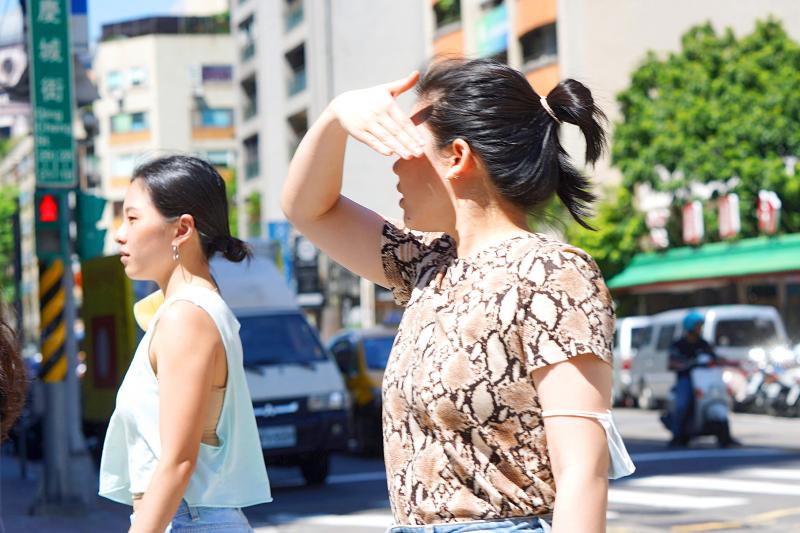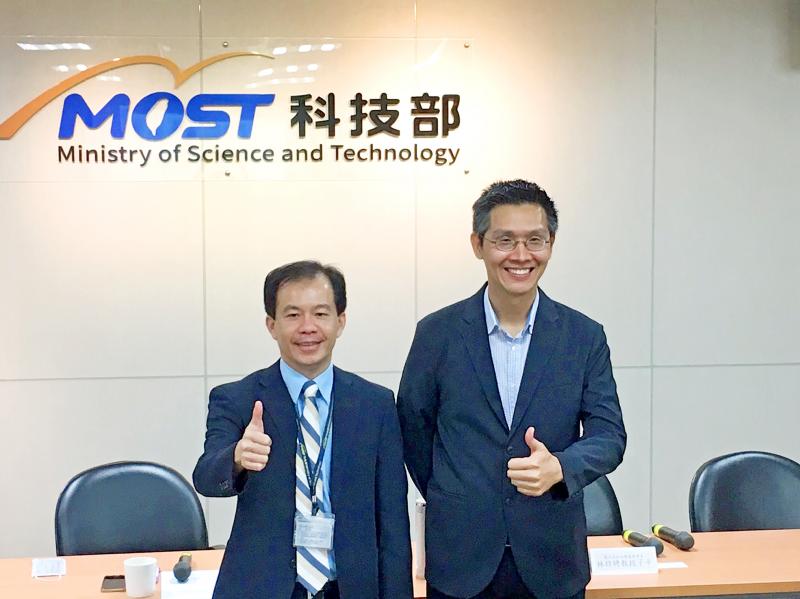An academic yesterday introduced a microclimate assessment system to identify warmer areas in cities as he advised urban planners to “set aside a pathway for the wind” to mitigate the urban heat island effect.
Global warming might be a distant issue for some people, but the urban heat island effect, or urban warming, is an everyday reality that affects people’s health and increases their power bills, National Cheng Kung University architecture professor Lin Tzu-ping (林子平) told a news conference at the Ministry of Science and Technology in Taipei.
Lin said he seeks solutions to urban warming at his Building and Climate Laboratory at the university.

Photo: CNA
To understand microclimate systems in cities, his team has installed 150 to 200 thermometers on lighting poles in Taipei, New Taipei City, Taichung, Tainan and Kaohsiung over the past three years, Lin said.
The team also used anemometers to collect pertinent data in selected hotspots, he added.
Citing last year’s findings, Lin said that the average summer nighttime temperature in central Tainan was found to be 3°C to 4°C higher than in the suburbs.

Photo: Yang Mien-chieh, Taipei Times
The team’s simulations showed that every square meter of a house in downtown Tainan might consume an additional 19 kilowatt-hours of electricity per year compared with that of a house in the suburbs, he said.
In Taipei and New Taipei City, residents living near the Keelung River (基隆河) and the Sindian River (新店溪) might not feel as cool as they had expected, as artificial structures block the wind blowing from the rivers, Lin said.
Cooling, ventilating and shading are three key methods to mitigate urban warming, the team said, citing its findings.
These could be achieved by building more green landscape and shading structures, and leaving pathways for the wind, as well as using less air conditioning, Lin said.
The team has presented its findings to the five municipalities to help them improve their management of buildings, he added.
However, the data could not be incorporated into the Central Weather Bureau’s public notification channels, as the information is not precise enough, he said.
Nonetheless, the data might offer useful information about apparent temperature, by which people could decide whether to visit a location, he said, adding that some government agencies in Japan regularly announce such temperature indices.
A mobile app for the assessment system is being tested, Lin said.
After the app becomes available, the team’s microclimate data might be used to improve tourism services, the efficiency of agricultural and fisheries sectors, labor safety standards and large-scale urban renewal planning, he said.

Taiwan is to commence mass production of the Tien Kung (天弓, “Sky Bow”) III, IV and V missiles by the second quarter of this year if the legislature approves the government’s NT$1.25 trillion (US$39.78 billion) special defense budget, an official said yesterday. Commenting on condition of anonymity, a defense official with knowledge of the matter said that the advanced systems are expected to provide crucial capabilities against ballistic and cruise missiles for the proposed “T-Dome,” an advanced, multi-layered air defense network. The Tien Kung III is an air defense missile with a maximum interception altitude of 35km. The Tien Kung IV and V

The disruption of 941 flights in and out of Taiwan due to China’s large-scale military exercises was no accident, but rather the result of a “quasi-blockade” used to simulate creating the air and sea routes needed for an amphibious landing, a military expert said. The disruptions occurred on Tuesday and lasted about 10 hours as China conducted live-fire drills in the Taiwan Strait. The Civil Aviation Administration (CAA) said the exercises affected 857 international flights and 84 domestic flights, affecting more than 100,000 travelers. Su Tzu-yun (蘇紫雲), a research fellow at the government-sponsored Institute for National Defense and Security Research, said the air

Taiwan lacks effective and cost-efficient armaments to intercept rockets, making the planned “T-Dome” interception system necessary, two experts said on Tuesday. The concerns were raised after China’s military fired two waves of rockets during live-fire drills around Taiwan on Tuesday, part of two-day exercises code-named “Justice Mission 2025.” The first wave involved 17 rockets launched at 9am from Pingtan in China’s Fujian Province, according to Lieutenant General Hsieh Jih-sheng (謝日升) of the Office of the Deputy Chief of the General Staff for Intelligence at the Ministry of National Defense. Those rockets landed 70 nautical miles (129.6km) northeast of Keelung without flying over Taiwan,

A strong continental cold air mass is to bring pollutants to Taiwan from tomorrow, the Ministry of Environment said today, as it issued an “orange” air quality alert for most of the country. All of Taiwan except for Hualien and Taitung counties is to be under an “orange” air quality alert tomorrow, indicating air quality that is unhealthy for sensitive groups. In China, areas from Shandong to Shanghai have been enveloped in haze since Saturday, the ministry said in a news release. Yesterday, hourly concentrations of PM2.5 in these areas ranged from 65 to 160 micrograms per cubic meter (mg/m³), and pollutants were